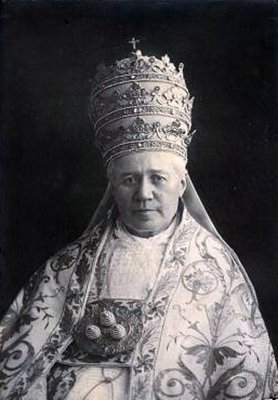The Scourge of the Modernists
A Man of True Humility

Pope Saint Pius X:
Defender of the Faith, Model of Heroic Holiness
September 3 marks the annual feast of St. Pius X, Pope and Confessor. Born on June 2, 1835, Giuseppe Sarto (English: Joseph Tailor) was ordained a priest on September 18, 1858 and consecrated a bishop on November 16, 1884. Pope Leo XIII created him a cardinal on June 12, 1893. When Pope Leo died in 1903, the conclave elected Cardinal Mariano Rampolla del Tindaro to succeed him. However, due to a veto issued against Rampolla before the conclave by the Austrian emperor Franz Joseph — a right that had been granted to the emperor by the rules of the conclave then in force — Rampolla’s election was void, and the conclave had to choose a different candidate. On August 4, Cardinal Sarto was elected Pope and took the name of Pius X.
The cardinals’ choice of Sarto as Pope and the veto against Rampolla turned out to be among God’s greatest blessings ever granted to His holy Church. Rampolla, it turned out, had been a secret Freemasonic infiltrator into the Church; and Sarto, the man chosen as Pope in his stead, ended up becoming the first canonized Pontiff in centuries. Full of charity, piety, apostolic zeal and unbounded fortitude, Pope Sarto defended God’s Church most valiantly and prudently against the errors of his (and our) time, especially Modernism, which he termed “the synthesis of all heresies.”
Not only did St. Pius expose and condemn the Modernist errors, but he also acted to ensure that everything humanly possible would be done to counteract and defeat the threat of this deadly spiritual poison. In 1907, he issued a syllabus of 65 Modernist errors that he severely condemned, and a few weeks later published his landmark anti-modernist encyclical Pascendi Dominici Gregis. In 1910, His Holiness imposed the famous Oath Against Modernism, which he required to be sworn by all Catholic clergy and seminary professors.
During his glorious pontificate Pope Pius also established the Sodalitium Pianum, the diocesan vigilance committees, to exterminate Modernism at its roots, and excommunicated and punished those who would not amend (the most famous cases being those of Fr. Alfred Loisy and Fr. George Tyrrell).
On December 22, 1907, St. Pius X personally consecrated the bishop who would become his immediate successor as Pope Benedict XV, Giacomo della Chiesa, who in turn ended up consecrating his successor, Eugenio Pacelli (Pius XII), on May 13, 1917, the day of the first apparition of Our Lady of Fatima in Portugal, “at the very hour” Our Lady first showed herself to the shepherd children (Walter H. Peters, The Life of Benedict XV [Milwaukee, WI: Bruce Publishing, 1959], p. 217).
On August 20, 1914, Pope Pius X died in heroic sanctity at the Apostolic Palace. He was beatified by Pope Pius XII in 1951 and canonized a saint of the Catholic Church by the same Pontiff on May 29, 1954, a mere 40 years after his passing. The tomb of St. Pius X is located under an altar in St. Peter’s and can be seen in this photo here. St. Pius was incorrupt for decades, though it has been said that his body began to decay after the take-over of the Modernist Vatican II Sect now occupying the Vatican structures.
St. Pius X chose as his papal motto Instaurare Omnia in Christo – “to restore all things in Christ”. This he worked for most heroically, and for this he merited to hear these most blessed words: “Well done, good and faithful servant… enter thou into the joy of thy lord” (Mt 25:21).
Below we are providing some links to his most important documents, some amazing video, and other tidbits.
Sancte Pie X, ora pro nobis.
Actual Video Footage of Pope St. Pius X walking with an unknown bishop in 1912
Pius X’s Most Important Doctrinal Papal Documents:
- E Supremi – on the Restoration of All Things in Christ (1903)
- Acerbo Nimis – on the Teaching of Christian Doctrine (1905)
- Vehementer Nos – on Separation of Church and State (1906)
- Lamentabili Sane – the Syllabus of Modernist Errors (1907)
- Pascendi Dominici Gregis – on the Doctrine of the Modernists (1907)
- Praestantia Scripturae – on the Bible & Modernism (1907)
- Editae Saepe – on St. Charles Borromeo (1910)
- Sacrorum Antistitum – the Oath Against Modernism (1910)
- Our Apostolic Mandate – on Sillonism (1910)
Videos & Tidbits on St. Pius X:
- Gli Uomini Non Guardano Il Cielo – The only Movie ever made about Pope Pius X (Italian)
- Ecclesiastical Milestones of Pope St. Pius X – Catholic-Hierarchy.org
- Incredibly Rare Video Footage of Pius X alive: St. Pius X walking in Vatican Gardens
- Video Footage: The Canonization of Pope St. Pius X
- Photo Collection: Saint Pius X
- Extensive Photo Collection: Pope Saint Pius X
- The Canonization of Pope St. Pius X in Pictures
- Book Recommendation: Saint Pius X: Restorer of the Church by Yves Chiron, with many gorgeous photos
- Modernism’s Eternal Foe, Our Eternal Friend: St. Pius X and the Conciliar Church by Tom Droleskey
- Litany of Pope St. Pius X
Image: public domain



No Comments
Be the first to start a conversation